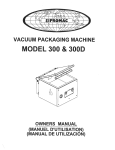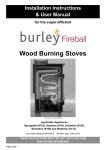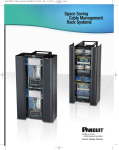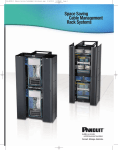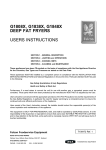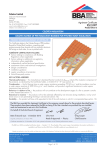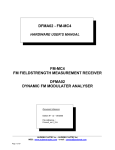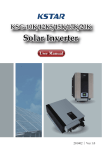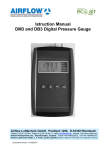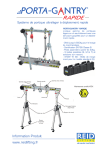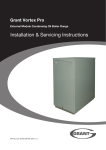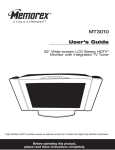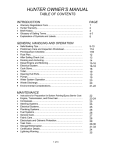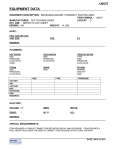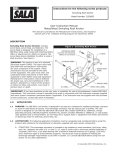Download Grant Solar Thermal Solutions Technical Manual
Transcript
Solar Thermal Grant Solar Thermal Systems On-Roof, Flat Roof and In-Roof Systems Installation & User Instructions Part No. DOC 73. Rev. 02 June 2010 System Options On-Roof Flat Roof In-Roof Portrait (side by side) Portrait (side by side) Landscape (one above other) Landscape (side by side) Landscape (one above other) Portrait (one above other) System Options Grant solar collectors are slender in appearance and are extremely durable with an extruded Aluminium frame and 4mm thick low iron glass. 2 Grant Aurora Grant Sahara with high quality Silver finish anodized frame, this contemporary look is a stylish feature to accentuate the property and looks great on dark roof coverings such as slate. with a Bronze anodized frame, this blends with most domestic roof types, providing an aesthetically pleasing appearance. Contents Installation sequence of solar collectors 36 7.2 Installation of solar collectors On-Roof and Flat Roof 37 4 4 1.3 Organisation of the installation instructions 4 1.4 Safety instructions and symbols 4 8.1 Compression connection, straight 39 1.5 Safekeeping of installation instructions 4 8.2 1.6 Installation 4 Compression connection, landscape systems only 40 1.7 Equipment and materials to be provided 5 1.8 Tools required 5 Standards and guidelines Package Contents Standard installation kits and roof fixings (Roof-mounted system only) 6 7 7 Dimensions & Fixing Intervals 8 3.1 On-Roof system 8 3.2 Flat Roof system 9 In-Roof systems On-Roof System Installation 4.2 6 7.1 Package contents 4.1 5 4 Product description 3.3 4 36 1.2 2.1 3 Installation of Solar Collectors 1.1 1.9 2 7 Installation summary Profile tile 10 Roof Penetrations 9.1 Roof penetrations 10 Differential Controller 10.1 General information 39 41 41 43 43 10.2 Technical data 43 10.3 Operation 44 10.4 Sensors 44 11 Electrical Installation 11.1 Electrical connection 45 45 12 User Guide 46 13 12.1 Operation 46 14 12.2 Starting up 47 12.3 Explanatory information 47 Flat tile 15 4.4 Slate tile 16 4.5 Alignment and fixing of mounting rails 17 4.6 Joining mounting rails 17 18 5.1 Installation summary 19 5.2 Flat Roof system installation 20 5.3 Joining mounting rails 20 In-Roof System Installation 9 Hydraulic Connections 12 4.3 Flat Roof System Installation 8 23 6.1 Installation summary 24 6.2 Substructure 26 6.3 Installation of In-Roof kit 28 6.4 Installation of collectors 33 6.5 Fitting top cover flashing 35 6.6 Closing the roof 35 13 Solar Pump Station 51 13.1 Solar pump station 51 13.2 Installation and operation 52 14 Commissioning the System 56 14.1 Heat transporting fluid 56 14.2 Instructing the operator 56 14.3 Filling and flushing the system 57 15 Commissioning Commissioning check list 59 59 16 Maintenance 61 17 De-commissioning 62 18 Warranty 63 Contents 1 Installation Instructions General 3 1 General The following information is a stepby-step guide to the installation and operation of the Grant Solar Thermal system. 1.1 Product Description The Grant Solar Thermal system uses flat plate solar collectors that can be fitted in either a ‘portrait’ or ‘landscape’ configuration and offers three different mounting methods – ‘On-roof’, ‘In-roof’ and ‘Flat-roof’. The ‘On-roof’ and ‘In-roof’ mounting kits are designed for use on roof slopes of between 20° and 65° and must be installed in accordance with these instructions. The ‘Flat-roof’ mounting kit can be used on any flat surface capable of carrying the weight of the collectors and any dead weighting used. In-Roof Systems only: A waterproof membrane must be used on all roofs. On older roofs the sarking felt is acceptable but if this is not present, then a breathable waterproof membrane must be fitted and it should end at the eaves (roof guttering). General Short term damp can occur beneath the roof covering (tiles or slates) on roof slopes of less than 20° or greater than 65°, or where there are long rafters or joined roofs, as a result of extreme weather conditions (e.g. driving rain, snow covering or ice formation). This can be avoided by using additional wedge section sealing strips. However, adequate ventilation of the roof must still be provided. 4 Installation kits for ‘On-roof’ installations are supplied with roof anchors to suit the type of roof covering concerned – i.e. profile tiles, flat tiles or slates. This must be specified when the kit is ordered. Before commencing installation check that the roof anchors supplied are correct for the roof type. If the height of profile tiles is particularly high a special adjustable height roof anchor is available. Contact Grant for details. If necessary, the installation can be modified to suit the site conditions. However, any changes must be approved by Grant and must meet Building Regulations, codes of practice, and any relevant local bylaws and regulations in force at the time. Failure to comply with this will invalidate the product warranty. 1.2 Package Contents Solar collectors, fixing components and other system accessories must be handled with care during storage and transport. If the packaging is damaged during transit this must be immediately reported to the supplier/delivery driver. Before starting installation check the kit supplied contains all the required components. Refer to Section 2.1. All packing materials must be disposed of appropriately after installation. 1.3 Format of installation instructions These instructions describe the installation of collectors in both the ‘portrait’ and ‘landscape’ format using all three mounting types – ‘On-roof’, ‘Flat roof’ and ‘In-roof’. This is covered in Sections 4, 5 and 6 respectively. The actual fitting of the collectors and the connection to the hydraulic solar circuit is identical for all the above mentioned mounting options, and is covered in Sections 7 and 8 respectively. 1.4 Safety Instructions and Symbols When installing the system, take note of the safety instructions in this document. The symbols used in the text are explained below: ! Caution: This symbol draws attention to a potential hazard! ! Note: This symbol indicates useful information or a general note. 1.5 Safekeeping of the Installation Instructions These Installation & User Instructions must be handed over to the householder on completion of the installation. They should be kept for future reference as necessary. 1.6 Installation Installation must be carried out by a competent installer in compliance with all current local planning requirements, Building Regulations, codes of practice, Health and safety legislation, and any relevant local bylaws and regulations in force at the time. All electrical installation work must be carried out by a qualified electrician. All wiring and earth bonding must comply with current IEE wiring regulations. In-roof and On-roof installations only: When installed, both the In-roof and On-roof systems can experience uplift due to the wind. When installing either system ensure that the collectors are installed no less that THREE tiles from any roof edge. Important: All system pipe connections must use compression fittings with brass olives. Soft soldered joints must NOT be used on the solar primary circuit. Plastic pipe must NOT be used for any part of the solar primary circuit. All internal solar primary system pipework should be insulated using suitable high temperature resistant pipe insulation. 1.7 Equipment and Materials to be provided 1.8 Tools Required General: • Heat conducting paste - for temperature sensors (optional) • Screwdriver (6mm hexagon socket) On-roof and Flat roof installations: • Pencil • Tape measure or folding rule On-roof Installation: • 2 ‘Grant’ lead flashings or 2 ‘Solardek’ flashings or 2 vent tiles (see Section 9) • Fixing screws for fixing battens/roof anchors • 17/19mm open-jaw spanners (x2) • 13mm open-jaw spanner • Screwdrivers (standard and cross-head) • Electric screwdriver/drill Flat roof installation: If the supporting frame is secured by weights rather than being screwed down, the weights must conform to the following specifications for a wind pressure zone up to 8 m building height and a snow load zone up to 0.75 kN/m2 (Table 1). In-roof installation: Table 1: Dead Weight Requirements • Socket wrench with T-handle, size 6 Flat Roof installation Up to 8m • Pencil • Tape measure or folding rule • 2 open-jaw spanners 17/19mm • 1 open-jaw spanner 13/14mm • Screwdrivers (standard and cross-head, sizes 2 and 3) 1 solar collector 290 kg • Electric screwdriver with socket bit for sealing screw (8mm hexagon) 2 solar collectors 580 kg • Hammer 3 solar collectors 870 kg • Solar collector carrying handles 4 solar collectors 1160 kg • Torx T25 screwdriver 5 solar collectors 1450 kg Commissioning: As weights, lawn edge stones can be used, for example. Permissible roof load must not be exceeded under any circumstances, and if necessary a structural engineer must be consulted beforehand. If the substructure has been penetrated, it must be carefully re-sealed in accordance with technical standards. • Filling station • Pressure gauge • Screwdriver (flat bladed) In-roof Installation: General • Fixing screws for mounting battens 5 1 General 1.9 Standards and Approvals General Grant flat plate solar collectors conform to the requirements of BS EN 12975 Thermal solar systems and components – Solar collectors, and have the ‘Solar Keymark’ approval. 6 2 Package Contents 2.1 Standard Installation Kits For ‘On-roof and ‘Flat roof’ Installations (in portrait format) Table 1: Installation Kit Contents Standard 1 Article Collector Kit Mounting rail extension kit only Mounting hook 2 Cylinder bolt 4 Fixing bracket 4 Anchor block 4 Collector flow/return pipe c/w insulation 2 Collector to collector connector c/w insulation 0 Installation and operating instructions 1 Standard 2 Standard 3 Standard 4 Standard 5 Collector Kit Collector Kit Collector Kit Collector Kit 2 2 (plus extension kit) 4 4 (plus extension kit) 4 6 8 10 8 12 16 20 8 12 16 20 8 12 16 20 2 2 2 2 1 2 3 4 1 1 1 1 On-Roof installation Roof anchor* 4 6 8 Flat Roof installation Flat roof angle frame 2 3 3 Securing cruciform kit 1 1 1 * Roof anchor - to suit type of roof covering (see pages 14 to 17) - Slate - Flat tile - Profile tile 10 12 4 1 5 1 For ‘In-roof’ Installations (in portrait format) Standard 1 Standard 2 Standard 3 Standard 4 Article Collector Kit Collector Kit Collector Kit Collector Kit Mounting bracket 4 8 12 16 Anchor block 4 8 12 16 Collector flow/return pipe c/w insulation 2 2 2 2 Collector to collector connector c/w insulation 0 1 2 3 Cylinder bolt 4 8 12 16 Side gutter LH 1 1 1 1 Side gutter RH 1 1 1 1 Base tray – lower section** 1 2 3 4 Base tray – upper section** 1 2 3 4 Cover strip 2 3 4 5 Bottom apron flashing 1-piece*** 1 0 0 0 Bottom apron flashing LH*** 0 1 1 1 Bottom apron flashing RH*** 0 1 1 1 Bottom apron flashing Intermediate*** 0 0 1 2 Bottom flashing 1-piece**** 1 0 0 0 Bottom flashing LH**** 0 1 1 1 Bottom flashing RH**** 0 1 1 1 Bottom flashing Intermediate**** 0 0 1 2 Top cover flashing 1-piece 1 0 0 0 Top cover flashing LH 0 1 1 1 Top cover flashing RH 0 1 1 1 Top cover flashing Intermediate 0 0 1 2 Closure strip 0 1 2 3 Fixing screw 14 28 44 60 Clip c/w nail 12 12 12 12 Foam draught seal wedge 6 6 6 6 Foam draught seal block 2 3 4 5 Mastic bead (roll) 1 1 1 1 Torx screwdriver bit (T25) 1 1 1 1 Installation and operating instructions 1 1 1 1 ** Maybe supplied as one tray *** Bottom apron flashing used for tiles only **** Bottom flashing used for slates only Standard 5 Collector Kit 20 20 2 4 20 1 1 5 5 6 0 1 1 3 0 1 1 3 0 1 1 3 4 76 12 6 6 1 1 1 Table 3: Timber Battens (to be supplied by the installer) – minimum lengths (mm) Bottom batten (30 x 50) Lower middle batten (30 x 90) Upper middle batten (30 x 90) Top batten (30 x 50) 1460 1460 1460 1460 2645 2645 2645 2645 3835 3835 3835 3835 5025 5025 5025 5025 6215 6215 6215 6215 Package Contents Table 2: Installation Kit Contents 7 3 Dimensions & Fixing Intervals 3.1 On-roof Installation Position of Roof Anchors and Mounting Rails 60mm 60mm 2042mm 2042mm ~1800mm 2374mm ~1800mm 1187mm ~200mm ~800mm ~200mm max. ~700mm 500mm Figure 1: 1 collector (portrait) ~700mm max. 500mm Figure 2: 2 collectors (portrait) 3561mm 4748mm ~1800mm 60mm ~1800mm 60mm 2042mm 2042mm max. 500mm ~1300mm ~1300mm max. 500mm Figure 3: 3 collectors (portrait) max. 500mm ~1300mm ~1300mm Figure 4: 4 collectors (portrait) 5935mm 60mm ~1800mm 2042mm 8 ~1700mm ~1700mm ~1700mm Figure 5: 5 collectors (portrait) 4205mm 60mm ~900mm 1142mm Dimensions & Fixing Intervals max. 500mm max. ~1100mm 500mm ~1100mm Figure 6: 2 collectors (landscape) ~1100mm max. 500mm max. 500mm ~1300mm max. 500mm 3.2 Flat-roof Installation Position of Roof Anchors and Mounting Rails 2374mm 1770mm 60mm 60mm 2042mm 2042mm 1770mm 1187mm ~250mm 700mm* ~250mm ~500mm Figure 7: 1 collector (portrait) ~700mm =700mm* ~500mm Figure 8: 2 collectors (portrait) 3561mm 4748mm 1770mm 60mm 1770mm 60mm 2042mm 2042mm ~500mm ~1300mm =1200mm* ~500mm Figure 9: 3 collectors (portrait) ~500mm ~1300mm ~1300mm =1200mm* ~500mm Figure 10: 4 collectors (portrait) 60 1334mm 1316mm 2042mm 1770mm 5935mm ~1300mm ~1300mm Figure 11: 5 collectors (portrait) * This is a fixed dimension and must be as shown above ~1300mm =1200* ~500mm 1320mm 1318mm 54mm Dimensions & Fixing Intervals ~500mm 9 3 Dimensions & Fixing Intervals 3.3 In-Roof System Installation Position of Mounting Rails 1-5 Solar Collectors, Vertical, Side by Side 160 160 160 50 50 50 160 50 2645mm 1460mm 100 2450mm 2450mm 340 340 100 100 190 190 100 Figure 12: 1 collector (portrait) Figure 13: 2 collectors (portrait) 160 160 50 160 50 3835mm 160 50 5025mm 100 50 340 2450mm 2450mm 340 100 100 Figure 14: 3 collectors (portrait) Figure 15: 4 collectors (portrait) 160 50 190 190 100 160 6215mm 50 10 100 190 Dimensions & Fixing Intervals 2450mm 340 100 Figure 16: 5 collectors (portrait) Note: Dimensions include cover frame 3.3 In-Roof System Installation Position of Mounting Rails 1-5 Solar Collectors, Horizontal, Side by Side 160 50 160 2355mm 160 50 160 50 50 4440mm 100 1550mm 1550mm 340 340 100 100 190 190 100 Figure 17: 1 collector (landscape) Figure 18: 2 collectors (landscape) 160 50 160 50 6525mm 1550mm 340 100 190 100 Figure 19: 3 collectors (landscape) 160 160 50 50 8615mm 1550mm 340 100 190 100 Figure 20: 4 collectors (landscape) 160 50 10700mm 1550mm 340 100 190 100 Dimensions & Fixing Intervals 160 50 Figure 21: 5 collectors (landscape) Note: Dimensions include cover frame 11 4 On-Roof System Installation On-Roof System Installation See Section 9 for details of roof penetrations. 12 4.1 Installation Summary Item Description The standard installation kit allows solar collectors to be fitted vertically onto horizontal mounting rails. Mounting rails are fixed to the roof structure using the appropriate type of roof anchors for the roof covering - e.g. slates, flat tiles or profile tiles. 01 Collector 02 Mounting rail set 03 Roof Anchors -A profile tile B flat tile C slate roof 04 Rail profile 05 Anchor block 06 Collector connection kit 07 Collector to Collector connection kit 08 Cylinder anchor bolt 09 Fixing Bracket 10 Interlocking bolt 11 Hydraulic connection 12 Insulation 13 Temperature sensor 14 Mounting hooks Figure 22: Installation Summary, Vertical Solar Collector Layout 07-A 12 11 06 01 13 04 03-A Profile tile 08 09 03-C Slate 02 05 14 Roof Anchor Options 04 10 03-A On-Roof System Installation 03-B Flat tile 13 4 On-Roof System Installation 4.2 Profile Tile 2. Expose the installation area above the rafters. For roof anchor intervals, see Page 8, 3.1 On-Roof System installation. Note: As a rule, pushing up the roof tiles is sufficient. Horizontal positioning of roof anchors is dependent on the rafters and the tile valleys. 65 mm 120mm Caution: Never attach safety harness to the installation system! m 40m 60mm Roof Anchors fixed to Rafters 1. For profile concrete tiles, these roof anchors are attached directly to the roof rafters (rafter-mounted installation). 70 mm m 0m 15 Figure 23: Dimensions of Roof Anchor A istance Horizontal-D lignment Horizontal-a e nc sta Di alrtic Ve nment Vertical-alig On-Roof System Installation Figure 24: Horizontal and Vertical Alignment 14 3. Place roof anchor (03-A) in line with the top edge of the roof tile in the tile valley. Fix the base plate of the roof anchor to the rafter with screws (16). 16 03 4. Fix all further roof anchors in the same way. For roof anchor intervals, see Page 8, 3.1 On-Roof System installation. Note: Roof anchors must be horizontally and vertically aligned (follow roof tile valleys). Figure 25: Installation of Roof Anchors A m 30m 4.3 Flat Tile Caution: Never attach safety harness to the installation system! 40mm 125mm 75mm Roof Anchors fixed to Rafters 1. For flat concrete tiles, these roof anchors are attached directly to the roof rafters (rafter-mounted installation). 65 mm 20 0m m 2. Expose the area above the rafters. For roof anchor intervals, see page 8, 3.1 On-Roof System. Note: As a rule, pushing up the roof tiles is sufficient. Horizontal positioning of roof anchors is dependent on the rafters and the tile valleys. 10 0m m Figure 26: Dimensions of Roof Anchor B istance Horizontal-D lignment Horizontal-a e nc sta Di alrtic Ve nment Vertical-alig Figure 27: Horizontal and Vertical Alignment 3. Place roof anchor (03-B) in line with the top edge of the roof tile. Fix the roof anchor to the rafter with screws (16). On-Roof System Installation 4. Fix all further roof anchors in the same way. For roof anchor intervals, see Page 8, 3.1 On-Roof System installation. Note: Roof anchors must be horizontally and vertically aligned (follow roof tile valleys). Figure 28: Fixing Mounting Battens and Roof Anchors 15 4 On-Roof System Installation 4.4 Slate Tile m 30m 65 mm 50mm Roof Anchors fixed to Rafters 1. On slate roofs, additional mounting battens are fixed to the roof substructure. Roof anchors ‘C’ are fixed through the slate tiles to the mounting batten (batten-mounted installation). 25 0m m Caution: Never attach safety harness to the installation system! 2. Expose the area required for installation (length of mounting batten). For roof anchor intervals, see Page 8, 3.1 On-Roof System installation. Note: As a rule, pushing up the roof slates is sufficient. Horizontal positioning of roof anchors is dependent on the rafters and the tile valleys. Figure 29: Horizontal and Vertical Alignment istance Horizontal-D lignment Horizontal-a e nc sta Di alrtic Ve nment Vertical-alig Figure 30: Horizontal and Vertical Alignment Note: If roof is fully sarked (timber boards) then mounting anchors should be screwed through sarking into the rafters below. On-Roof System Installation 3. Mounting battens (18) are fixed with screws to the rafters at a distance of 185mm from the roof batten below. 16 Note: The distance of 185mm is dependent on the roof anchor and type of roofing and must be modified if necessary. 16 16 17 4. Place the roof anchor (17) on to the slate tile and mounting battens and fix with screws (16). 17 18 5. Fix all further roof anchors in the same way. For roof anchor intervals, see Page 8, 3.1 On-Roof System installation. Note: Roof anchors must be horizontally and vertically aligned. Figure 31: Fixing Mounting Battens and Roof Anchors Figure 32: Fixing Mounting Battens and Roof Anchors through Sarking 4.5 Alignment and Fixing of Mounting Rails 1. Close the roof covering at the top and bottom. 2. Fix top mounting rail (04) to the roof anchor (03). Position the heads of interlocking bolts (10) parallel to the mounting rail (04) and place them on the mounting rail, push the interlocking bolts to the top in the roof anchor (03) and secure with a 90° turn. Tighten the nuts of the interlocking bolts (hand tight). Use serrated washers to secure the nuts. Figure 33: Roof Covering with Roof Anchors 04 Install all further mounting rails in the same way. 3. Align the mounting rails horizontally and vertically so that the rails and the roof tiles are parallel. Diagonal dimensions between mounting rails must be equal: D1 = D2 03 10 Tighten the nuts on the interlocking bolts. Installation of solar collectors: See pages 33 to 35. 4.6 Joining Mounting Rails 1. On some installations it may be necessary to join two or more sections of mounting rail to create a longer length of rail. Figure 34: Fixing the Mounting Rail D1 2. Join the sections of rail using the screws and fishplates (supplied in the fixing kit provided), as follows: D2 Fit the fishplate into the rectangular opening at the end of the one section of mounting rail. Refer to Figure 36. Figure 35: Aligning the Mounting Rail On-Roof System Installation Align the threaded hole in the fishplate with the hole in the rail (50mm from the rail end), fit the cylinder bolt provided and tighten to secure. Refer to Figure 37. Fit the exposed end of the fishplate into the rectangular opening of the second mounting rail. As before, align the threaded hole of the fish plate with the hole in the rail, fit the cylinder bolt and tighten to secure the second rail section to the first. Refer to Figure 38. Repeat this process for all other connections between mounting rail sections. Now go to Section 7. Figure 36: Installing the Fishplate Figure 37: Fixing the Fishplate Figure 38: Joining Mounting Rails 17 Flat Roof System Installation 5 Flat Roof System Installation 18 5.1 Installation Summary Item Description The standard installation kit allows solar collectors to be fitted vertically onto horizontal mounting rails. 01 Collector 02 Mounting rail set 03 Roof Anchors -C to flat roof anchors 04 Rail profile 05 Anchor block 06 Collector connection kit 07 Collector to collector connection kit 08 Cylinder anchor bolt 09 Fixing Bracket 11 Hydraulic connection 12 Insulation 13 Temperature sensor 14 Mounting hooks 15 Cruciform Figure 39: Installation Summary, Vertical Solar Collector Layout 07-A 12 11 01 06 13 08 09 02 05 03-C 14 04 Flat Roof System Installation 04 19 5 Flat Roof System Installation 5.2 Flat Roof System Installation 1. Lay mounting rails on the installation surface with the wide groove uppermost. Mounting rail interval = 1770mm. Diagonal dimensions between mounting rails must be equal: D1 = D2 70 17 D1 04 D2 a Figure 40: Installation of the First Flat Roof Mounting Bracket 04 2. Open out a prefabricated flat roof mounting bracket and place the long L-profile on the mounting rail so that the T-profile points backwards. For interval a, see Page 9, 3.2 Flat roof installation. SW 13 3. Fix the flat roof mounting bracket to the mounting rail using the interlocking bolts, serrated washers and nuts provided. Note: Interlocking bolts must be secured to the mounting rail using a 90° turn. Flat Roof System Installation 4. Place the next flat roof mounting bracket on the mounting rail and fix using the interlocking bolts. Do not tighten the bolts too tightly, as final adjustment may be required. For interval b, see Page 9, 3.2 Flat roof installation. 20 Figure 41: Fixing Using Interlocking Bolt Figure 42: Installation of the Second Flat Roof Mounting Bracket a b 5. Unscrew securing cruciform (24). It is fixed to the legs of the flat roof mounting bracket and the mounting rail. B A Place the angled long ends of the securing cruciform between the flat roof mounting bracket and fix with bolts (M8x18), washers and nuts. Note: Always fit the stays of the securing cruciform to the right hand side of the flat roof mounting angles. See detail views (A and B). 6. Tighten the nuts on the interlocking bolts If necessary, modify the position of the second flat roof mounting bracket. Note: Use punching bolt (15) with offset screw tip for fixing to the mounting rail. Do not confuse with cylinder bolt (08)! 24 Figure 44: Installation of the Second Flat Roof Mounting Bracket 24 15 21 03-C 08 15 22 22 04 Figure 43: Punch bolt/cylinder bolt Tighten the punching bolt until a clear snap is heard. Continue to turn and tighten normally. Caution: Turning the punching screw fixes the securing cruciform into its final position; check distances and correct seating of the interlocking nuts beforehand. Figure 45: Fixing the Securing Cruciform and Mounting Rail 5.3 Joining Mounting Rails 1. On some installations it may be necessary to join two or more sections of mounting rail to create a longer length of rail. 2. Join the sections of rail using the screws and fishplates (supplied in the fixing kit provided). Refer to the procedure given in section 4.6 (on page 17). Flat Roof System Installation 7. Place an interlocking nut (23) in mounting rail (04) and secure it in the mounting rail by turning it 90°. Place a spacer sleeve (22) on the interlocking nut and fix the stays of the securing cruciform (24) using locking washer (21) and punching bolt (15). 21 5 Flat Roof System Installation 8. Fix all further flat roof mounting brackets to the mounting rails in accordance with steps 2-4, and fix the legs tightly using cylinder bolts M8x18mm. For mounting bracket intervals see Page 9, 3.2 Flat roof installation. 9. Place the flat roof mounting frame together with the T-profiles, align according to plan and make the structure robust. To prevent damage to the roof covering, it may be necessary to use protective mats. If the flat roof mounting frame is not bolted to the building structure, it must be secured according to technical requirements. Caution: The flat roof mounting frame must be adequately weighted down or bolted. If the supporting frame is secured by weights rather than being screwed down, the weights must conform to the following specifications for a wind pressure zone up to 8 m building height and a snow load zone up to 0.75 kN/m2, according to the table. Permissible roof load must not be exceeded under any circumstances, and if necessary a structural engineer must be consulted beforehand. If the substructure has been penetrated, it must be carefully re-sealed in accordance with technical standards. 03-C Figure 46: Fixing Additional Flat Roof Mounting Brackets Table 3: Dead Weight Requirements Flat roof installation Up to 8m 1 solar collector 290 kg 2 solar collectors 580 kg 3 solar collectors 870 kg 4 solar collectors 1,160 kg 5 solar collectors 1,450 kg 22 1m Flat Roof System Installation protective mats Figure 47: Robustness (Weighting) Now go to Section 7. In-Roof System Installation 6 In-Roof System Installation 23 6 In-Roof System Installation 6.1 Installation Summary 07 12 The In-Roof installation kit allows the solar collectors to be fitted into the roof covering (tiles or slates) either horizontally or vertically. 04 06 11 05 08 13 22 06 04 03 04 17-B 20 05 08 02-B 03 21 19 17-A 20 02-B 21 10-B 19 10-B ** The standard Grant in-roof kit for slate roofs may not be suitable for some reclaimed slate, uneven or rough slate roofs. In this case please contact Grant UK for advice and assistance regarding suitability. 09-B 20 02-A 14 01 Figure 48: Installation Summary Vertical Collector Installation 16-B 10-A 14 09-A 01 10-A In-Roof System Installation 14 Item Description Item Description Item Description 01 Bottom batten (30 x 50mm)* 08 Cylinder anchor bolt 16-A 02-A Lower middle batten (30 x 50mm)* 09-A Side gutter - Left hand Bottom apron - Left hand flashing (for tiles) 09-B Side gutter - Right hand 16-B Upper middle batten Middle batten (30 x 90mm)* 10-A Base tray - lower section Bottom apron - Right hand flashing (for tiles) 10-B Base tray - upper section 17-A Top cover - Left hand flashing 11 Hydraulic connection 17-B 12 Insulation Top cover - Right hand flashing 13 Temperature sensor 18 Fixing screw - not shown 14 Cover strip 19 Clip (with nail - not shown) 15-A** Bottom flashing - Left hand (for slates) 20 Foam draught seal wedge 21 Foam draught seal block 15-B** Bottom flashing - Right hand (for slates) 22 Closure strip 02-B 24 16-A 03 Top batten (30 x 50mm)* 04 Mounting bracket 05 Anchor block 06 Collector connection kit 07 Collector to collector connection kit (portrait collectors only) * Battens to be supplied by installer. Dimensions given are for guidance - batten thickness must match existing tile battens. Timber must be treated e.g. Tanalised or similar. 22 13 04 06 04 08 05 04 03 23 17-B 08 04 20 21 05 02 09-B 19 03 17-A 20 21 02 19 14 01 20 16-B 10-A 14 09-A 10-B 14 01 10-B 16-A 10-A Figure 49: Installation Summary Landscape Collector Installation Item Description Item Description Item Description 01 Bottom batten (30 x 50mm)* 08 Cylinder anchor bolt 16-A 09-A Side gutter - Left hand Bottom apron - Left hand flashing (for tiles) 02 Middle batten (30 x 90mm)* 09-B Side gutter - Right hand 16-B 10-A Base tray - left half Bottom apron - Right hand flashing (for tiles) 03 Top batten (30 x 50mm)* 10-B Base tray - right half 17-A Top cover - Left hand flashing 04 Mounting bracket 11 Hydraulic connection 17-B 12 Insulation Top cover - Right hand flashing 13 Temperature sensor 18 Fixing screw - not shown 14 Cover strip 19 Clip (with nail – not shown) 20 Foam draught seal wedge 21 Foam draught seal block 22 Closure strip 23 Collector to collector connection kit (landscape collectors only) 05 Anchor block 06 Collector connection kit * Battens to be supplied by installer. Dimensions given are for guidance - batten thickness must match existing tile battens. Timber must be treated e.g. Tanalised or similar. 15-A** Bottom flashing - Left hand not shown (for slates) 15-B** Bottom flashing - Right hand not shown (for slates) In-Roof System Installation ** The standard Grant in-roof kit for slate roofs may not be suitable for some reclaimed slate, uneven or rough slate roofs. In this case please contact Grant UK for advice and assistance regarding suitability. 25 6 In-Roof System Installation Important: The standard Grant in-roof kit for slate roofs may not be suitable for some reclaimed slate, uneven or rough slate roofs. In this case please contact Grant for advice and assistance regarding suitability. 6.2 Substructure Caution: Do not attach safety harness to the integrated roof installation system! 1. Remove tiles in the installation area. Intervals must be above those given on Page 10/11. For ease of installation, an additional continuous row of roof tiles is required. Caution: Adequate rear ventilation of the integrated roof installation must be provided using suitable means (e.g. cross battens). A waterproof membrane (waterproof membrane) is absolutely essential. Horizontal-Distance Horizontal-alignment nce ista l-D tica Ver 2. Remove the last roof tile in the row and position the bottom fixing batten (01) supplied by installer between 180 and 230mm up from the existing roof batten below - such that the fold in the bottom flashing sits exactly on the top edge of the tiles - see Figure 52 and 53. Secure the bottom batten to the rafters with screws (supplied by installer). In-Roof System Installation Note: The screws for fixing the horizontal fixing battens must be provided by the installer. m 0m 18 Note: The specified thickness for the battens is 30mm. If the existing roof battens are thicker then it will be necessary to either pack out the battens or use thicker ones so the top of each batten is flush with the existing roof battens. Figure 50: Remove Roof Covering 01 Do not use sealing screws (16) supplied in the installation kit. 03 Existing Tile Batten 180 mm 26 Figure 51: Screw Comparison Figure 52: Bottom Fixing Batten Table 4: Fixing Batten Spacing Intervals between fixing battens (mm) for In-roof installation portrait 03 02-B 02-A B C 01 landscape Dimension side by side side by side A 2025 1125 B 260 260 C 1110 N/A A 180 -23 0mm Figure 53: Top, Upper middle, Lower middle and Bottom Horizontal Fixing Battens In-Roof System Installation 3. Align the upper middle batten (02B), the lower middle batten portrait only (02-A) and top (03) to the bottom horizontal batten (01). Refer to table for the intervals between the battens. Secure the battens to the rafters with screws (supplied by installer). 27 6 In-Roof System Installation 6.3 Installation of In-Roof Kit 01 1. Fit the bottom flashings. 06-A and 06-B Note: The lead aprons on the bottom apron flashings (16-A & 16-B) for use with tiles are supplied folded back. Carefully fold out the lead aprons before installation. Do not modify the flashings or lead aprons. Leave the protective film in place on the butyl tape at this stage. Table 5: Overall Width Dimensions Overall width dimensions (mm) for In-roof installation Qty portrait (side by side) landscape (side by side) 1 1460 2355 2 2645 4440 3 3835 6525 4 5025 8615 5 6215 10700 Figure 54: Installation of Bottom Flashing Note: butyl tape has strong adhesive properties and mistakes cannot be rectified after application! In-Roof System Installation Figure 55: Installation of Additional Bottom Flashings 28 2. Position the bottom flashings on the bottom batten - with the left flashing overlapping the right in the centre. Adjust width of the bottom flashing to suit - see Table 5. Adjust the position of the bottom flashing as required to centre it in the opening in the roof tiles/slates or to avoid the need to cut tiles on one (or both) sides. le 5 g width refer to Tab For bottom flashin Mark position of both ends of bottom flashing on batten. Remove left hand flashing and fix right hand flashing to batten using suitable small screws (not supplied). Remove the protective film from the butyl tape on the right hand flashing. Ensure left hand flashing is correctly located, re-position on batten, pressing firmly on overlap to seal. Fix left hand flashing to batten using suitable screws (not supplied). Repeat procedure for any further bottom flashing sections, as required. Note: For slates, use the mastic bead supplied in the kit to seal the bottom flashing (15-A and 15-B) to the roof. Place the bead on the underside of the flashing, along the entire length, remove backing strip and press down to seal two slates. Table 6: Position of Base Tray Dimension C Portrait 145mm Landscape 165mm For ‘Portrait’ installations (refer to page 24) c Figure 56a: Installation of Lower Base Tray 3. Fit first lower base tray (10-A). Position side of tray at distance ‘C’ from end of bottom flashing, with lower edge along the fold line of the bottom flashing – see figure 56c. Fix to lower middle batten (02-A) using a single screw – at the centre of the upper edge – see Figure 56a. Do NOT use one of the sealing screws provided in the installation kit for this fixing. Fit first upper base tray (10-B). Locate the lower edge of upper base tray into top of lower base tray until the side channels touch. Fix to upper middle batten (02-B) using one of the self-drilling sealing screws provided in the installation kit at the centre of the upper edge – see Figure 56b. c Figure 56b: Installation of Upper Base Tray 09 Bottom edge of base tray on fold line of bottom flashing Figure 56c: Section Through Bottom Flashing In-Roof System Installation 06-A and 06-B 29 6 In-Roof System Installation 4. Fit second lower base tray. As with first lower base tray, position it with the lower edge along the fold line of the bottom flashing. Ensure gap between trays does not exceed 4 mm – see Figure 57c. Fix to lower middle batten as before using a single screw – see Figure 57a. Fit second upper base tray – locating it into top of lower tray and fixing to upper middle batten using one of the self-drilling sealing screws provided in the installation kit at the centre of the upper edge – see Figure 57b. For installations using more than two collectors, repeat the above procedure to fit further lower and upper base trays as necessary. Figure 57a: Installation of First Base Tray In-Roof System Installation Figure 57b: Installation of Second Base Tray 30 mm 0-4 Figure 57c: Maximum Gap Between Base Trays For ‘Landscape’ installations (refer to page 25) Figure 58a: Installation of First Tray 5. Fit first right hand (RH) half base tray (10-B) with upwards facing return fold towards centre. Position side of RH half base tray at distance ‘C’ from end of bottom flashing with lower edge along the fold line of the bottom flashing – see figure 56c. Fix to middle batten (02) using one of the self-drilling sealing screws provided in the installation kit at the centre of the upper edge – see Figure 58a. Fit first left hand (LH) half base tray (10-A), hooking the downwards facing return fold into the corresponding fold on the fixed RH half base tray. Position LH half base tray with lower edge along the fold line of the bottom flashing. Fix to middle batten using one of the selfdrilling sealing screws provided in the installation kit at the centre of the upper edge – see Figure 58b. Figure 58b: Installation of Second Tray 6. Fit second RH half base tray. As with the first tray, position it with the lower edge along the fold line of the bottom flashing. Ensure gap between trays does not exceed 4mm – see Figure 57c. Fix to middle batten using one of the selfdrilling sealing screws provided in the installation kit at the centre of the upper edge – see Figure 59a. Fit second LH half base tray – hooking over fold on RH half base tray, with lower edge along fold line of bottom flashing. Fix with a single screw as before – see Figure 59b. Figure 58d: Installation of Fourth Tray For installations using more than two collectors, repeat the above procedure to fit further RH and LH half base trays as necessary. In-Roof System Installation Figure 58c: Installation of Third Tray 31 6 In-Roof System Installation For either ‘Portrait’ or ‘Landscape’ installation continue as follows: 7. Fit side gutter (09). Position side gutters against side of base tray with bottom edge along fold line of bottom flashing. Ensure that outer edges of each side gutter is located INSIDE the return edge on the bottom flashing. 8. Secure side gutters in place using the clips provided. Hook the clips over the outer edge of the side gutters and fix to battens using the nails provided. Figure 60: Installation of Side Gutter Figure 63: Securing Side Gutter Clips 9. Fit cover strip on the joint between the base tray and side gutter. Fit the end of the strip onto the two outward facing flanges - see Figure 64. Slide cover strip up the full length of the joint. Finally fold over at both ends of cover strip to secure - see Figure 65. Repeat to fit cover strips on the other side gutter and on all joints between the base trays. Figure 61: Location of Clips on Side Gutters In-Roof System Installation Figure 64: Installation of Cover Sheets 32 Figure 62: Fitting of Cover Strips Figure 65: Installation of Cover Sheets 6.4 Installation of Collectors 1. Position mounting brackets (04) at the bottom of the base tray using the dimensions given in Figure 68. Carefully mark their position on the base tray with a pencil. Important: Ensure brackets are correctly positioned with the two holes at the top. Remove protective film from underside of brackets and press them into place in the correct position. Fix in place with the self-drilling screws supplied in the kit using the Torx 25 screwdriver bit provided in the kit. Refer to Figure 67. Figure 66: Location of bottom Mounting Brackets 100 16 100 100 10 Figure 67: Fixing of bottom Mounting Brackets 04 Figure 68: Bottom Mounting Bracket Dimensions In-Roof System Installation 10 33 6 In-Roof System Installation 2. Fit two anchor blocks (05) into the profile at the bottom and top of each collector. Lift first collector and position on two mounting brackets. See Figure 69. Adjust position of anchor blocks to align with hole in each mounting brackets. Repeat for second collector, and so on for further collectors. 3. Install the top mounting brackets after collectors have been fitted onto bottom mounting brackets. Remove the protective film from the underside of two mounting brackets. Lift top end of one collector and position the two mounting brackets (with the holes at the top) against the top edge of the collector. Lower the collector and press the bracket into place on the base tray. Fix in place with the self-drilling screws supplied in the kit using a Torx 25 screwdriver. Refer to Figure 71. Figure 69: Installation of the Collectors on to Bracket 4. Adjust position of the two anchor blocks in top collector profile to align with the hole in the two mounting brackets. Fit the two cylinder bolts through the top mounting brackets into the anchor blocks and tighten. Repeat for bottom mounting brackets. 5. Repeat procedure for second collector, and so on, as required. 6.5 Fitting Top Cover Flashing Note: Figure 70: Installation of the Top Brackets In-Roof System Installation Flow and return system pipework, and connections between collectors, should be completed and tested before fitting closure strip(s) and top cover flashings to collectors. 34 1. First fit closure strip to cover the gap between two collectors. Locate one of the two long flanges on the underside of the closure strip against the side of one of the two adjacent collectors. Push on the other flange until the closure strip clips into place between the collectors. 2. Ensure that the closure strip is contact with the collector sides over its entire length. Slide the closure strip up or down, as necessary, to align it with the top and bottom with the ends of the collectors. Fold the closure strip ends over the top and bottom of the collectors to secure the closure strip in place. Figure 71: Fixing of the Top Brackets 3. Repeat this process to fit further closure strips, as required. 07-B 4. Fit right hand top flashing first. Locate slot in lower edge of flashing onto top edge of collector. Ensure right hand end of flashing is fitted INSIDE the return edge on the right hand side gutter. 5. Fit left hand top flashing onto top edge of collector, overlapping the right hand flashing in the centre. Ensure left hand end is fitted INSIDE the return on the left hand side gutter. Fix the right hand flashing to the batten beneath using the self-drilling screws provided in the kit. See Figure 73. 6. At the centre, lift the end of the left hand top cover flashing and remove the protective film from the Butyl tape on the right hand flashing. Press down the end of the left hand flashing to seal. Fix the left hand flashing to the batten beneath using the self-drilling screws provided in the kit. Figure 72: Fitting right Top Cover Flashing (07-B) to Collector 07-A 6.6 Closing the Roof 1. If necessary, the right roof tile row must be cut. It may also be necessary to remove the upstands fitted to the roof tiles on the sheet side (side cover sheet). Note: To improve the weather-tightness of the roof covering, optional foam wedges can be bonded to the side flashings before closing the roof area. 2. Roof tiles above the solar collector field are usually cut also. Overlapping for the top cover sheets must be carried out according to the following values for roof incline: Figure 73: Fixing left hand Top Cover Flashing (07-A) 14 Figure 74: Fitting Foam Block (14) In-Roof System Installation = 35° at least 120mm > 35° at least 100mm > 50° at least 80mm Important: Following installation the collectors must be covered, to stop solar radiation reaching them, until completion of filling and commissioning. Figure 75: Position of Foam Sealing Wedges 35 7 Installation of Solar Collectors Figure 76: Connections for Portrait Format Collectors Mounted Side by Side B A 19 In accordance with solar collector connection and installation type, there are small differences in the installation sequence of solar collectors. A 19 Figure 77: Connections for Landscape Format Collectors Mounted one Above the Other 7.1 Installation Sequence of Solar Collectors • If the installation kit contains straight compression fittings, these must be installed during solar collector installation. Refer to section 8.1 • If the installation kit contains angled compression fittings, these must be installed after solar collector installation. Refer to section 8.2 B B 19 Figure 78: Connections for Two Landscape Format Collectors Mounted Side by Side Installation of Solar Collectors The choice of Outlet (flow) connection ‘A’ and inlet (return) connection ‘B’ for the collector array is up to the installer - to suit the installation. Caution: Locate the temperature sensor of the solar controller in the sensor pocket next to the outlet (flow) connection of the collector array 19 Figure 79: Connections for Two Portrait Format Collectors Mounted one Above the Other 36 A A B Important: All system pipe connections must use compression fittings with brass olives. Soft soldered joints must NOT be used on the solar primary circuit. A Figure 80: Connections for Three Landscape Format Collectors Mounted Side by Side 19 Plastic pipe must NOT be used for any part of the solar primary circuit. B Now go to Section 7. 7.2 Installation of Solar Collectors - On-Roof and Flat Roof 01 1. Note: Do not carry the solar collectors by their connections. Use carry handles! 05 To install carry handles, fit anchor blocks (05) to the solar collector profile and fix the carry handles using two cylinder bolts M8x14 (08). 2. Fit two mounting hooks (14) per solar collector in the lower mounting rail. Fit the mounting hooks into the mounting rail so that they will be 100mm away from the edge of the solar collectors 08 Figure 81: Fixing the Carry Handles Distance c : For portrait collector format approx. 800mm 3. Place the first solar collector on the mounting rail/mounting hook and align. 14 04 Distance to left-hand mounting rail edge = 39mm C 4. Remove carry handles from the first solar collector and attach them to the next solar collector. mm 39 Figure 82: Positioning the Mounting Hooks 09 05 04 Figure 83: Installing the Anchor Blocks for the Fixing Brackets Installation of Solar Collectors 5. Install anchor blocks (05) at the end of the mounting rail (04) and place them so that the fixing brackets (09) can be screwed flush to the ends of the mounting rail. mm 00 ~1 37 7 Installation of Solar Collectors 6. On the left outer edge of the solar collector (01), hook in two fixing brackets (09) into the solar collector profile (a) and push them down on to the mounting rails (b). Secure the fixing brackets in the anchor blocks using M8x14 cylinder bolts. 7. Secure the solar collector using two further fixing brackets on the opposite side: 01 09 A A B B Figure 84: Hook Fixing Brackets in the Solar Collector Profile • Place anchor blocks in the mounting rails • Hook fixing brackets into the solar collector 11 • Secure using cylinder bolts M8x14 8. Place the compression fitting (11) on the connector of the first solar collector. 9. Hook two further mounting hooks into the lower mounting rail, see Figure 82, Positioning the Mounting Hooks. 09 09 Figure 85: Align Anchor Block for Additional Fixing Brackets 10. Place another solar collector on the mounting rail/mounting hooks and remove the carry handles. 45mm 11. Place anchor blocks for the second solar collector in the mounting rail and align so that the fixing brackets can be fixed finally side by side. A 12. Install fixing brackets into the solar collector profile and push them down onto the mounting rails. 13. Push the second solar collector up to the first solar collector until the ends of the fixing brackets touch using cylinder bolts M8x14. B Figure 86: Hook Fixing Brackets in the Solar Collector Profile Important: All system pipe connections must use compression fittings with brass olives. Soft soldered joints must NOT be used on the solar primary circuit. Installation of Solar Collectors Note: Take care with compression fitting! Guide the second solar collector’s connector into the compression fitting! 38 14. Continue in the same way to install additional solar collectors. Important: Following installation the collectors must be covered, to stop solar radiation reaching them, until completion of filling and commissioning. Plastic pipe must NOT be used for any part of the solar primary circuit. 01 14 01 Figure 87: Align Second Solar Collector 8 Hydraulic Connections 8.1 Compression Connection, Straight 19mm 17mm 1. Tighten the nuts on the compression connection (11). Caution: Apply opposite force when tightening the compression connection, otherwise the pipes on the solar collector can be damaged! 2. After successfully checking the seal of the solar collectors, place thermal insulation (12) around the hydraulic connection, and remove the protective film from the adhesive strip to secure it in place. 3. Continue in the same way to install additional solar collectors. 4. Inlet connection (A) and outlet connection (B) for the solar collector field is left to the installer to choose. Figure 88: Hydraulic Connection 12 Caution: Locate the solar collector temperature sensor (19) in the sensor pocket next to the Outlet (flow) connection of the collector array. 5. Push back the thermal insulation on the solar collector connection kits, place the compression connections onto the connectors and secure. Caution: Push the solar collector temperature sensor to the end of the hose sleeve so that the correct measuring point is reached. Figure 89: Fit Thermal Installation B A 19 01 01 01 Figure 90: Solar Collector Field Attachment 19mm Important: All system pipe connections must use compression fittings with brass olives. Soft soldered joints must NOT be used on the solar primary circuit. 14mm 06 01 Plastic pipe must NOT be used for any part of the solar primary circuit. 13 Hydraulic Connections 6. Take the temperature sensor seal (13) out of the solar collector hole next to the outlet (flow) connection, pierce the centre and push it over the temperature sensor. Finally, guide the temperature sensor fully into the sensor pocket of the solar collector and seal by re-inserting the temperature sensor seal. 19 Figure 91: Connection of Temperature Sensor 39 8 Hydraulic Connections 8.2 Compression Connection, Landscape Systems Only 1. Fit the two 15mm compression elbows supplied on to the two adjacent solar connectors using the 15/12mm reducing sets provided in the kit. Turn the elbows so that the openings face each other as shown. Do not fully tighten at this stage. 2. Measure a length of 15mm copper pipe (not supplied) required to connect the two elbows. Cut the 15mm pipe to the required length using a pipe cutter. 3. Remove the elbows from the collectors. Fit the insulation onto the copper pipe, fit the pipe between the elbows and refit them to the collector connectors. 4. Tighten the compression elbows. Caution: Apply opposite force when tightening the compression connections, otherwise the pipes on the solar collector can be damaged! 5. After successfully checking the seal of the solar collectors fit the thermal insulation on the pipe and elbows. 6. Continue in the same way to install additional solar collectors. Important: All system pipe connections must use compression fittings with brass olives. Soft soldered joints must NOT be used on the solar primary circuit. Hydraulic Connections Plastic pipe must NOT be used for any part of the solar primary circuit. 40 Figure 92: Hydraulic Connection, Landscape Installation 9 Roof Penetrations 9.1 Roof Penetration For On-Roof Systems Only 1. There are several options for making weathertight roof penetrations, including: Ventilation Tiles Increase the opening in the ventilation tile to allow the Insulated pipes to pass through, or remove the grill inserts if possible. Locate the ventilation tiles adjacent to the collector connections. Lead Flashings Remove the tiles adjacent to the collector connections. Drill a 25mm hole in the tile using a diamond tipped bit. Locate the flashing below the drilled tiles, with the copper pipe passing through the drilled hole ‘SolarDek’ Flashings These have a coated lead base with a silicone centre section that is cut off to suit the diameter of the pipe. Figure 93: Solar Collector Field Attachment for On-Roof Systems These can replace the tiles adjacent to the collector connections. Figure 95: Lead Flashing Figure 96: SolarDek Flashing Roof Penetrations Figure 94: Ventilation Tile 41 9 Roof Penetrations 2. Push the thermal insulation for the solar collector connection kits (06) up to the solar collector. For Ventilation Tiles Pass the insulated pipes through the opening in the ventilation tile for connection inside the roof space. ~60mm For Lead Flashings Cut the insulation and fit over the copper pipe on the flashing. Pass the flexible connection pipe through the copper pipe/flashing for connection inside the roof space. For ‘SolarDek’ Flashings Cut the insulation to fit on to the silicone seal. Cut the silicone seal to give the required diameter hole for the pipe. Pass the pipe through the silicone seal for connection inside the roof space. Figure 97: Detail View of Solar Collector Field Connection - On-Roof Systems 3. If the substructure is punctured, the roof covering must be re-sealed afterwards! Guide the connection pipes into the correct position through the waterproof membrane. The seal can be restored by attaching overlapping strips of waterproof membrane, for example. Overlap must be a minimum of 100mm! For In-Roof Systems Only 4. The flow and return connection pipes can be located beneath the top flashing where they can pass through the waterproof membrane. Roof Penetrations Figure 98: Detail View of Solar Collector Field Connection - On-Roof Systems 42 Figure 99: An Example of Passing Through the Waterproof Membrane 10 Differential Controller Figure 100: Grant GSD1 Differential Controller Safety Information Power Connection Regulations Please install as per current electrical regulations. Your heating control system must be installed and serviced only by appropriately authorized specialists. ! If this system is not installed properly, there is a risk of fatal or severe personal injury. Warranty Conditions If the system is not installed, commissioned, serviced and repaired professionally, this will render the manufacturer's warranty null and void. Important Text Passages Important information is highlighted with an exclamation mark. ! ! 10.2 Technical Data Safety Information Declaration of Conformity This device corresponds to the requirements of the relevant guidelines and standards, if the corresponding regulations and the manufacturer's instructions are complied with. Function This controller enables the regulation of various types of system: 1) Solar regulation 2) Solid fuel boiler regulation The device is simple to operate and easy to control due to the direct temperature display in the first operating level. This attention symbol indicates dangerous situations. Installation For information on connection of the Differential Controller, see page 42. Note: Please follow the safety information and read these instructions carefully before putting the system into operation. Supply voltage complying with DIN IEC 60 038 230 V AC ± 10% Power consumption Max 4 VA Switching capacity of the relays 250 V 2(2) A Maximum current on terminal L1´ 6.3 A Type of protection complying with DIN EN 60529 IP 40 Protection class complying with DIN EN 60730 II, Totally insulated Power reserve of the timer > 10 hours Permitted ambient temperature during operation 0 to 50°C Permitted ambient temperature for storage -30 to 60°C Sensor resistances F1, F3 and F4: Multiplier PT1000, 1kΩ +/- 0.2% at 0°C Differential Controller 10.1 General Information 43 10 Differential Controller 10.3 Operation (F1) System 1 = Solar Differential Regulation 230V~; Switching capacity of relays 2(2)A, 250V~ Mains power: 20 Supply to device and pump A1 19 N-conductor for device 17 N-conductor for collector pump (A1) 16 Supply connected to collector pump L1´ (A1) Sensors: 1+7 Collector sensor (F1) 4+5 Sensor, bottom of storage tank (F4) Switching conditions for A1 (P = set value): Refer to pages 46 & 47. Heat production - difference to storage tank and min. temp.: ON: F1 - F4 > P30 + P31 and F1 > P40 + 5K OFF again: F1 - F4 < P30 or F1 < P40 Maximum storage tank temperature: OFF: F4 > P50 ON again: F4 < P50 - 5K Maximum collector temperature: OFF: F1 > P41 ON again: F1 < P41 - 10K (A1) (F4) Figure 101: Sensor F1+F4: PT1000 10.4 Sensors F1 + F4: • silicone cable 1m length. • PT1000 sensor with 1kΩ +/- 0.2% at 0°C. Differential Controller Table 7: Sensor Characteristics 44 Temperature in °C Resistance in Ω -20 922 -10 961 0 1,000 10 1,039 20 1,078 30 1,118 40 1,155 50 1,194 60 1,232 70 1,270 80 1,309 90 1,347 100 1,385 110 1,422 120 1,460 ! If an error occurs, the symbol appears in the display and the associated error number appears, flashing. On pressing the three operating keys simultaneously, the parameters are reset to their default factory settings. Table 8: Sensor Errors Sensor fault No. Designation Significance E71 Collector sensor F1 defect The collector sensor has short circuited or there is an interruption E73 Storage tank The storage tank sensor F4 sensor has short circuited or defect there is an interruption E81 Eeprom A fault has occurred in the Eeprom. Please check values Note: Functional defects resulting from incorrect operation or settings are excluded from the terms of warranty. 11 Differential Controller Electrical Installation 11.1 Electrical Connection E E Limit Control 1 2 2 c Figure 102: Electrical Connection 1 c Cylinder Thermostat for bottom coil Important - ensure that: 1. the collector sensor (F1) is correctly located next to the ‘flow’ connection of the collector - refer to page 36. 3 Amp fused supply 2. the storage tank sensor (F4) is correctly located in bottom sensor pocket of the hot water storage cylinder. L N E 4 11 12 13 14 15 16 17 18 19 20 10 9 8 7 6 5 4 3 2 1 Solenoid Valve Solar pump Collector Figure 103: Wiring Diagram Pump Station Electrical Junction Box (not supplied) Figure 104: System Schematic Diagram 45 Electrical Installation Grant GSD1 Controller Differential Controller Twin-coil Cylinder 12 Differential Controller User Guide 12.1 Operation Explanation of the Operating Elements In Display Level (Normal Mode) OFF/ON/MANUAL switch ( / / ) prog Access the operating level by pressing the Plus and Minus keys simultaneously. (Automatic reset after 2 min. without operation). In Operating Level (Setting Parameters) Programming key (selection or input) Plus key (next value or increase value) Minus key (previous value or decrease value) prog Press the Plus and Minus keys simultaneously to return to the display level. OFF: The pump is not activated. ON: Normal operation; regulation according to settings. MANUAL: All pumps operate (all relays closed). The function is reset to Automatic mode after 30 min. User Guide Differential Controller Program Switch Settings 46 Display (Normal Mode) When in Normal mode, select the display required with the rotary knob at the front: Note: Please follow the safety information and read these instructions carefully before putting the system into operation. B Display the selected temperature / or time C Weekday 1=Monday - 7=Sunday; here Saturday D Pump operation indicator (Arrow = Pump ON) a = Pump A1 is ON (see connection diagram) E Operation indicator = OFF, = ON, ( = Hand => Pumps ON max. duration = 30 min.) When the total solar production in display C2 exceeds 10 MW, the three arrows appear above the text: " x 1000". F Figure 105: Rotary Knob A Designation of Temperature Displayed -Time F1 Temperature of collector or solid fuel boiler F4 Temperature of storage heater at bottom C1 Day's production in kW C2 Total production in kW. From 10 MW, display in MW (=> Arrow appears on " x 1000") A E B C D F Figure 106: Temperature Display The software number for your device appears briefly in the display. Finally, the standard display indicators appear. The controller is now in operation and uses standard values. To define the correct display, the time and weekday can now be entered. prog The standard display can be selected/changed using the rotary knob. ! prog Modify Set Values prog Display: Setting mode can be ended at any time by pressing the Plus and Minus keys simultaneously. Changes which have been entered but not stored by pressing the Prog key have no effect. Access the operating level by pressing the Plus and Minus keys simultaneously. Left No. of the set value, Right set value Use the Plus/Minus keys to select the number of the set value required [Display: left]. Press the Prog key => LED beside Prog lights up Set the time with the Plus/Minus keys ! A list of all the set values is provided on the following pages. Press the Prog key => Save the new time Press the Prog key => Select the set value. The LED beside the Prog key lights up. This means that the set value can now be modified with the Plus/Minus keys. Press the Plus key => Set value display "02" [left] Change the set value using the Plus/Minus keys. Press the Prog key => LED beside Prog lights up Press the Prog key => The modified value is saved. Set the weekday (17) with the Plus/Minus keys Press the Prog key => Save the weekday Setting mode can be ended at any time by pressing the Plus and Minus keys simultaneously. Changes which have been entered but not stored by pressing the Prog key have no effect. prog 12.3 Explanatory Information Time / Weekday Press the Plus + Minus keys simultaneously => Operating level with set value display "01" [left] ! Exit from the operating level by pressing the Plus and Minus keys simultaneously. Set Values Protected by Code No. (from No. 20) It is only possible to change the set values from No. 20 after entering the code number. These set values may only be modified by an authorized fitter. ! If these values are set incorrectly, they may cause malfunctions or damage to the system. • Select set value 20 (code No. input). • Press the Prog key and enter the 1 to 4-digit code number. Confirm each digit by pressing the Prog key. • Select the set value to be modified. • Press the Prog key and change the set value. • Conclude the input by pressing the Prog key. If an attempt is made to enter an impermissible value, the system automatically returns to set value 20 (enter code number). 47 User Guide Basic Setting of the Controller After the device has been properly installed, switch on the power supply: Press the Plus + Minus keys simultaneously => Normal mode with standard display. Differential Controller 12.2 Starting Up 12 Differential Controller User Guide Table 9: Set Values List No. Designation Setting Range Setting Ex Works 0.00 - 24.00 10.00 1-7 1 (Monday) User Set Values 01 Set time 02 Set weekday 03 Day's production Display only/Clear 0 04 Total production Display only/Clear 0 05 Pump kick function switch-on time 00.00 - 24.00 07.00 06 Pump kick function switch-off time 00.00 - 24.00 22.00 Fitter Set Values 20 Enter code No. 0000-9999 21 Code No. 0000-9999 0000 22 Select system 1-7 1 Switching Thresholds / Hystereses 30 Switching threshold for difference 1 1K – 30K 3 31 Hysteresis to switching threshold for 1 1K – 10K 3 Special Functions 40 Enable temperature, collector(s) (-20)°C – (+90)°C 35°C 41 Maximum collector temperature 80°C – 180°C 110°C 50 Maximum storage tank temperature 10°C – 130°C 60°C Pump Kick Function (Temperature Test Function) 60 Kick duration 61 Kick pause 62 Measuring time for 0.5K increase 0.2s – 59s 0 = OFF 10 min – 60 min 30 min 1 min – 5 min 1 min 0-100 0.0 = OFF User Guide Differential Controller Production Estimate 48 75 Volume flow fix for collector 1 [litre/min] 78 Mixing ratio 0 – 70 vol. % 40 % 79 Glycol type 0–1 0 Own Settings If the controller, e.g. for System 1 is used, only refer to the function descriptions related to this system. User Set Values 01 Set Time Set the current time (Indicators, pump kick function and reheating function). 02 Weekday Set the current weekday (1-7, 1=Monday) (Display only). Resetting the Production Indicators 03 Day's Production Indicator System 1 Only (System 2 -> No Function): Reset the value to "0000" by pressing the Prog key (for at least 2 seconds). The value is reset to "0000" at 24h. 04 Total Production Indicator System 1 Only (System 2 -> No Function): This value is updated at 24:00. => To determine the current total value accurately, the day's production value must be added to the "indicated" total production value. Reset the value to "0000" by pressing the Prog key (for at least 2 seconds). Each time the kick pause [P61] has ended, the corresponding collector pump is activated for the period of the kick duration [P60] (heat transport to the sensor). If a temperature increase of 0.5K is detected on the respective collector sensor during the measuring period [P62], the collector pump is activated for one minute. Finally, the switch-on conditions for the collector pump are checked. 05 Pump Kick Function Switch-On Time (Refer to "Pump kick function" section). 05 Pump Kick Function Switch-Off Time (Refer to "Pump kick function" section). Fitter – Set Values 20 Enter Code No. After entering the code number, the set values assigned to the fitter level can be modified. Standard value: 0000. 21 Valid Code No. The code number currently valid can be modified with this setting (Value only visible after entering the currently valid code No.). 22 System Selection (See Appended Diagrams) On selecting the system, the function of the device is redefined. Set the system number according to the connection descriptions (System 1 solar or System 2 solid fuel). ! After changing the System Selection parameter, all the set values are reset to the default factory values (including the code No.). The fitter level is closed. Switching Thresholds/Hystereses 30 Switching Threshold for Difference 1 The feeding function for storage tank I via pump A1 is activated when the temperature difference between sensor F1 (collector) and sensor F4 (bottom of tank) has exceeded the temperature [switching threshold + hysteresis = P30+P31]. The feeding function for storage tank I is deactivated when the difference falls below the set switching threshold. 31 Hysteresis to Switching Threshold for Difference 1. Special Functions 40 Enable Temperature, Collector System 1 Only (System 2 -> No Function): The collector pump is activated when the associated collector temperature exceeds the limit value set here by 5K. It is stopped when the collector temperature falls below the threshold temperature. This function prevents the pumps continuing to run when no relevant heat production is required. 41 Maximum Collector Temperature System 1 Only (System 2 -> No Function): The collector pumps are deactivated when the related collector temperatures exceed the safety limits set here. -> System protection The pumps are reactivated when the temperature falls below the temperature [maximum collector temperature – 10K]. 49 User Guide The chapter 'Explanation of Set Values/Functions' describes the various set values according to their dependence on the selected/realized system (1-2). Pump Kick Function (Temperature Test Function) System 1 Only (System 2 -> No Function): The pump kick function can be executed during the time period of the day in which solar production is expected [P05-P06]. This function should ensure that the actual collector temperature can be measured by the collector sensor even when the collector pumps are not operating. The function is deactivated when P05=P06="----" or P60=0. Differential Controller Explanation of the Set Values/Functions In order to modify the standard settings, refer to the chapter 'Electrical connections', select the relevant system according to the hydraulic systems illustrated and define these settings first of all. 12 Differential Controller User Guide 43 Maximum Storage Tank Temperature The maximum storage tank temperature is monitored by F4. In this case, the tank covering must be taken into account. ! The pump is deactivated when the temperature falls below the temperature [maximum storage tank temperature 5K]. Pump Kick Function (Temperature Test Function) System 1 Only (System 2 -> No Function): 60 Kick Duration [sec] Collector pump runtime following pump kick. 61 Kick Pause [min] If the collector pump has not run for the duration set here, the pump is activated for the kick duration period [P60]. User Guide Differential Controller 62 Measuring Time for 0.5K Increase [min] The course of the collector temperature is controlled during this period following a pump kick. If an increase of 0.5K is detected, the pump is started for a further minute. 50 Production Estimate System 1 Only (System 2 -> No Function): The controller can perform an estimated production calculation. To do this, enter the average volume flow through the respective collector when the charging pump is in operation [P75]. Refer to page 58 for volume flow rate. The volume flow is totalled during the runtime of the collector pump. The controller can calculate the solar heat production from the volume flow and the temperature difference F1 to F4. For the calculation, the heat transport medium used in the system (glycol type = P79) and the mixture ratio with water [P78] must be set. The day's production and total production are displayed in [kWh]; in the case of values in excess of 10 MW, the display of the total production changes to [MWh]. The change is indicated in the display by means of three arrows. The total production is updated on the same day. The day's production is reset to zero at midnight. Both values can be reset to zero at user level by means of the Prog key. 75 Volume Flow Fix for Collector 1 [Litre/min] Enter the average volume flow through the collector while the collector pump is in operation. The accuracy of this value directly influences the accuracy of the production calculation. 78 Mixture Ratio System 1 Only (System 2 -> No Function): Refer to the documents supplied for information on the mixture ratio of the heat transport medium (filling of the solar energy system) or ask the installation technician. 79 Glycol Type System 1 Only (System 2 -> No Function): (Solar-electricity system documents / installation technician). 0 = Propylene glycol 1 = Ethylene glycol Pump Blocking Protection The controller effectively prevents the pumps blocking following longer periods out of operation. The integrated protection function activates all the pumps which have not operated within the last 24 hours each day for approx. 5 seconds between 12:00 and 12:01. 13.1 Solar Pump Station Introduction A two-line solar pump station which include flow and return isolation valves. All other fittings for safe operation of the system are housed within this unit. Figure 107: Solar Pump Station • Flowmeter Features & Benefits • Flow meter - volume flow rate setting • Special solar pump • • Compact heat insulation Solar pump - tailored to solar installation (low volume flow rate high pressure difference) • Shut-off valve with gravity braking • • 6 bar safety valve Compact insulation - Efficient and attractive - prevents heat loss • Pressure gauge • Stop valves with gravity breaking • Connector expansion vessel • • Filling and flushing connector 6 bar safety valve - low vapour build-up - Long service life of component • Connection to expansion tank Quick installation • Flush/filling connections - For high pressure filling unit Components • System bleeding Figure 108: Components Solar Pump Station 13 Solar Pump Station 51 13 Solar Pump Station 13.2 Installation and Operating Instructions for OEM Solar Pump Station Art. No.s Description 222154 Station –1 Solar RS 15/6 Circulating pump GRUNDFOS SOLAR 15-60 130 Rp 3/4” Rp 3/4” 45 52 51 44 42 43 50 46 Technical Data Operating pressure: Max. 6 bar Operating temperature: Flow: Max. 140°C Return: Max. 120°C Medium: Water with max. 50% glycol 49 47 Internal dimension: DN 20 Screw connections: Flat-sealing union nut G1, 1 1/4” 48 Rp 3/4” Thermal conductivity: Expanded polypropylene (EEP) foam 0.025 W/mK Solar Pump Station Item Description 52 Figure 109: Pump Station Components 42 Flow ball valve with thermometer, integrated gravity brake 43 Return ball valve with thermometer, integrated gravity brake 44 Pressure gauge 45 Solar safety valve, 6 bar 46 Circulating pump 47 Flush/fill gate valve 48 Flow meter 49 Air collector 50 Bleed valve 51 Connection supports G 1/2” IG, closed off with plastic plugs 52 Expansion vessel connector For maintenance purposes (e.g. pump replacement) the flow and return ball valves must be closed (Figure 109, item 42 and 43) 522mm Insulation: GK-Cu Zn 37 Pb (2.0340.02) CuZn39Pb3 (2.0401) ca.548,5 Housing/ connecting parts: EPDM 305mm 62.5mm 125mm ca.166 75mm 60mm Materials: Gaskets: Figure 110: Dimensions Important: All system pipe connections must use compression fittings with brass olives. Soft soldered joints must NOT be used on the solar primary circuit. Plastic pipe must NOT be used for any part of the solar primary circuit. Function of Gravity Brakes Opening pressure of gravity brakes: 20 mbar each. Air Separator System Air Venting • No roof air venting required! • Expanded cross-section reduces flow speed • Venting in “calming zone” • Upstream installation: High temperature promotes air separation • Hand aspirator for bleeding air. The gravity brakes are incorporated into both the flow and return ball valve assemblies. They are operated by turning the handle on the ball valve. Figure 113: Ball Valve Opened To prevent the circulation of gravity pressure, the gravity brake must be in the operating position (closed). This means that the slots in the handles are in the vertical position. Figure 114: Gravity Brakes Opened To fill and completely empty the solar thermal installation, the gravity brake is opened by turning the handles to the right. The slots in the handles are at an angle of 45°. Figure 111: Air Separator 45 Figure 115: Ball Valve Closed 52 G 3/4” Figure 112: Safety valve and expansion vessel connections Turning the handles by 90° to the right. The slots in the handles are in the horizontal position. The ball valves are closed. Solar Pump Station Rp 3/4” 53 13 Solar Pump Station Connectors A submersible sleeve with a G 1/2” outer thread can be screwed into the ball valve (Figure 109, item 51) to enable a temperature sensor to be added. Wall Mounting • Drill 2 anchor point holes Ø 10mm, insert anchors • Screw the entire solar station with the accompanying plates and screws to the wall through the rear insulation jacket Solar Pump Station Figure 116: Wall Mounting Fixings 54 Important: The solar pump station must only be installed vertically as shown. Note: These Instructions are to be left with the Solar System Operator/Building Owner Important: All system pipe connections must use compression fittings with brass olives. Soft soldered joints must NOT be used on the solar primary circuit. Plastic pipe must NOT be used for any part of the solar primary circuit. Solar collectors Item Description 42 Flow ball valve with thermometer, intergrated gravity break 43 Return ball valve with thermometer, intergrated gravity break 44 Pressure gauge 45 Solar safety valve, 6 bar 46 Circulating pump 47 Flush/fill gate valve 47a Filling valve 47b Flushing valve 48 Flow meter 49 Air collector 50 Bleed valve 52 Expansion vessel connector 53 Filling station tank 54 Filling hose 55 Flushing hose 56 Filling station frame 57 Filling pump 44 Solar pump station 42 For maintenance purposes (e.g. pump replacement) the flow and return ball valve must be closed (item 42 and 43). 43 T T 55 46 47a Twin-coil cylinder 53 47 48 49 54 47b 57 Filling station Figure 117: Filling Diagram Solar Pump Station 56 55 14 Commissioning the System Following installation of the solar collectors and hydraulic connection of the collectors and piping, the system can be filled. When doing so, the thermal conditions and the particular features of the installation must be taken into account. For this reason, the system may only be filled, commissioned and maintained by a suitably authorised technician. To prevent damage to the system, the heat transporting fluid used to initially fill the system must be consistently used thereafter. Safety! If the system filling point (pump station) is located in the roof space, there should be a suitable flat surface on which to stand the filling station, eg floor, loft boarding or similar. 14.1 Heat Transporting Fluid In order to prevent frost and corrosion damage to the solar collectors and connections, the system may only be filled with a high-quality heat transporting fluid (propylene glycol and water mix). If the recommended readymixed fluid is used, this provides adequate frost protection to approx. 24 °C. 14.2 Instructing the Operator The installer must instruct the system operator in the function, operation and required servicing intervals of the system. Commissioning the System The system operator must be given the instructions for installation and use for safekeeping. 56 Figure 118: Filling Station Heat Transfer Fluid • Blue non-toxic heat transfer fluid Filling the System Before filling the system, check the expansion vessel charge pressure and adjust as required. Refer to Table 10. • Practically odourless based on 1.2 propylene glycol • • Good corrosion inhibitor • Remains stable over long period of time • Nitrate, phosphate and ammonia free • 40% solution of propylene glycol in water • 14.3 Filling and Flushing the System Connect pressure hose to the filling valve connection and open the valve • Connect the flushing hose to the flushing valve connection and open the valve • Using a slotted head screwdriver, close the flush/fill valve. Refer to Figure 120 Supplied ready mixed in 10 or 20 litres containers • Fill the filling station tank with sufficient solar fluid for the system Filling and Flushing Valves The stop valves on the flush/fill valve assembly are used for filling and flushing the solar thermal installation. • Check that Flow and Return ball valves are set half open. Refer to Figure 114 • Using filling station, fill the solar circuit and then flush for approx. 15 minutes • When the filling pump is running, close the flushing valve and set the system pressure to around 4 - 5 bar To enable filling/flushing, the slot in the flush/fill valve spindle must be in the horizontal position. See Figure 120. Important: The collectors must be cool before filling the system can commence. The collectors must be covered, to stop solar radiation reaching them, until completion of the filling and commissioning procedure. • When the pressure is reached, close the filling valve and immediately switch off the filling pump • Check that the device is leak-free. If the pressure gauge shows a significant drop in pressure, this points to a leakage in the system • Re-open the flush/fill valve • Switch on the circulating pump (control position “manual”) to the highest pumping level (III) and allow it to circulate for at least 15 minutes • Set the controller to “stand by” (pump = OFF) and then bleed the system using the hand ventilator on the air jet until the heat transfer fluid begins to escape • Set the operating pressure (as in Table 10) by carefully opening the flushing valve and releasing the fluid into the catchment tank of the filling pump • Switch on the circulating pump (controller set to manual) • Set the flow rate on the flow indicator (as in Table 11) by selecting the appropriate pump speed (I, II or III) and by using the flush/fill valve • Remove the hoses from the filling connections and screw the caps on the filling and flushing valves. Release the flushing valve first and then the filling valve • Note: Now switch the controller to automatic operation Filling Connection Flush/Fill Valve Figure 119: Heat Transfer Fluid Figure 120: Flush/Fill Valve Closed For Filling Figure 121: Flush/Fill Valve Open For Normal Operation Commissioning the System Flushing Connection 57 14 Commissioning the System Table 10: Initial Expansion Vessel Pressure and Operating Pressure Height Difference Initial Pressure for Expansion Tank Operating Pressure at 20°C (height of collector field height of expansion tank) (setting on valve, behind cover cap) (0.2 to 0.5 mbar greater than initial pressure) -5m ~1.0 bar ~1.3 bar < 0m ~1.0 bar ~1.3 bar < 5m ~1.5 bar ~1.8 bar < 10m ~2.0 bar ~2.3 bar < 15m ~2.5 bar ~2.8 bar > 15m Separate dimensioning of safety device required Table 11: Pipe diameters and flow rates Number of Solar Collectors Type of Connection Diameter of forward and return flow pipe Minimum volume flow Setting the Flow Rate The setting of the volume flow for the heat transfer fluid is made via the setting for the revolution levels (I, II, III) of the circulating pump and the restrictor in the flush/fill panel. The flow indicator displays the volume flow set. The display range is between 1 and 13 litres per minute. Note: For larger installations, please contact Grant Technical Department for assistance. ≤5 6 8 9 12 Up to 5 in series 2x3 parallel 2x4 parallel 3x3 parallel 4x3 parallel 15mm 18mm 18mm 22mm 22mm 2-3 l/min 4-5 l/min 4-5 l/min 6-8 l/min 6-8 l/min Releasing Trapped Air The residual air from the heat transfer fluid is collected in the air separator and manually released via the air vent. To do so, push a plastic tube on to the the air vent outlet and catch the fluid that is released in a suitable container. Ventilation may be carried out only by trained specialists. Unchecked ventilation leads to pressure loss and disruption in the system. Caution: Danger of scalding! The temperature of both the escaping air and the heat transfer fluid can exceed 100°C. Commissioning the System Figure 123: Releasing Trapped Air Read off the volume flow values on the top edge of the rotameter. Figure 122: Flow Indicator 58 15 Commissioning Commissioning Check List Grant Solar Thermal User Instructions explained and handed over? Yes/No Decommission schedule for collector and cylinder left on site? Yes/No Installation and maintenance instructions left on site? Yes/No Specialist maintenance schedule (including frequency, maintenance and list of parts to be replaced during normal maintenance) left on site? Yes/No System drawing indicating hydraulic, valve and electrical connections? Yes/No Store commissioning certificate completed and signed? Yes/No Conformity declarations for EU directives? Yes/No All documentation to be kept visibly near store protected from heat, water and dust. Name of location where documentation is left: Glazing format of solar collector: Absorber type: Net absorber or aperture area. Copy of EN 12975 conformity certificate left on site? What is max design temperature. Will system prevent collector overheating? Manufacturer’s name: Flat Selective 2.32m² Absorber Yes/No ºC Yes/No Grant UK Unique serial no: Maximum stagnation temperature of collector. 209 ºC Maximum design pressure of collector. 10 Bar Maximum design pressure of pre-heat store exchanger. 10 Bar Primary pressure limit of weakest component. System pressure setting adjusted when cold. Minimum allowable primary system pressure/level before user action required. Bar 2 Bar 0.5 Bar Procedure for user to follow if primary pressure/level is below limit. Location of primary system pressure gauge. Frequency of regular test of pressure safety device: Location of pressure safety device. Yearly Pumpstation Location of electrical fused isolating switch. Fuse rating. 3 Amps Electrical controls and temperature sensors operating correctly? Yes/No Non-solar DHW heating fitted with a thermostat responding to the solar pre-heat store? Yes/No Differential pump control setting. 35 ºC Hysteresis setting about differential switching points. 3 ºC Expansion capacity suitable to be inherently secure? Written warning left on site if there’s potentially no automatic resumption of normal operation after stagnation? Lowest ambient temperature of primary system without freeze damage. The heat transfer fluid provides freeze protection to. Type of transfer fluid. 2.5 Bar Litres Yes/No Not required -25 ºC -25 ºC Water/Glycol Maximum Ambient temp for pump. 30 ºC Minimum ambient temperature for pump. 0 ºC Commissioning Expansion vessel capacity. Circulation rate setting. Litres per minute Noise at full circulation acceptable. Yes/No Direction of circulation through collector heat exchanger matched to sensor positions? Yes/No 59 Commissioning Check List Expansion vessel pre-charge. 15 Commissioning Commissioning Check List Grant Solar Thermal Solar pre-heat store type. Solar primary heat exchanger type. Combined with DHW/ Separate from DHW Copper/ Steel/ Plain/ Ribbed Solar primary heat exchanger area. m2 Volume of dedicated solar pre-heat. Litres Location of DHW isolation valve. Method of anti-scalding in DHW distribution. Pump control/thermostatic mixer valve Location of digital temperature gauge fitted to monitor risk of DHW overheating. Limescale risk to heat exchanger. Limescale control in heat exchanger: Expected annual delivered solar energy to taps. Expected annual solar fraction of DHW. per cent Daily DHW load assumption Litres per day at ºC On behalf of Date system commissioned and handed over Signature of commissioning engineer Commissioning kWh SAP2005/ Other Commissioned by Commissioning Check List Cleaning hatch/ Thermostat on primary circulation Method of performance calculation. Date of site visits for bacterial, water quality and access risk assessments. 60 Low/ Medium/ High Signature of user to confirm receipt and understanding (optional) 16 Maintenance Grant Solar Thermal systems require only basic maintenance in order to ensure that they continue to give efficient trouble-free operation. The following procedures should be carried out annually. WARNING Before commencing any work on a solar thermal system cover the collectors and allow the system to cool down. 16.1 System checks Isolate the electrical power supply to all system controls. Check the following: 1 Collectors Collector fixings - ensure that they are secure – retighten if necessary. 3 Expansion vessel pressure Check the charge pressure in the vessel as follows: b) Open the small Drain cock on the connector and drain off a small amount of solar fluid into a clean container. Keep this fluid to test – see 2-Solar fluid below. c) Check the air charge in the vessel refer to section 14 for correct pressure. d) Adjust or re-pressurise the vessel as necessary to achieve the correct pressure. NB. This may require putting additional solar fluid into the system. Refer to Section 14 for system filling guidance. Check as per manufacturer’s recommendations (refer to instructions supplied with the cylinder). 2 Cylinder sensor - ensure it is correctly located and securely fitted. 16.4 Restarting system The following procedure should be followed to put the system back into operation: 1 System pressure – check cold system pressure (on pressure gauge) is correct for static height of system (refer to Section 14 – table 10 for details). Top-up or re-fill as required. 2 Controls - After reconnecting the power supply to controls, check the following: 16.2 Solar fluid Using the small amount of solar fluid removed from the expansion vessel, carry out the following tests: Pipe connections – check for any evidence of leaks and rectify as necessary. a) Using a Refractometer - check antifreeze concentration and level of protection. Pipe insulation – check insulation on exposed pipes and replace if damaged. b) Using suitable litmus indicator strips – check Acidity ph value. Collector sensor – ensure it is correctly located and securely fitted. Replace solar fluid as required if either test indicates the fluid is unsuitable. 2 System pipework Safety! If the replacement of solar fluid is required, and the system filling point (pump station) is located in the roof space, there should be a suitable flat surface on which to stand the filling station, i.e. floor, loft boarding or similar. PRV operation – test by briefly rotating plastic cap on valve to operate. 1 a) Close the isolation valve – on the expansion vessel connection Condition of collectors – check glazing is undamaged and clean glass to remove any dirt deposits if necessary. Leaks - visually inspect system for any evidence of leaks and rectify as necessary 16.3 Hot water storage cylinder Settings on Solar Controller are correct – Refer to Section 12 for details. Operation of Solar Controller – operate override and check that solar pump starts. 3 System flow – with the solar pump running check the volume flow rate and reset as necessary (refer to Section 14 – table 11 for details). NB. Ensure that correct system volume flow rate is also set in the solar controller. Maintenance Pipe insulation – check condition of pipe insulation and replace if damaged. 61 17 De-commissioning Procedures If the solar thermal system is to be taken out of use – either temporarily or for a longer period, the following procedure should be followed. WARNING Before commencing any work on a solar thermal system cover the collectors and allow the system to cool down. These covers should be removed when the decommissioning procedure is completed. 17.1 System Isolate the electrical supply to the solar thermal system. Remove fuse from fused isolator and lock off the isolator. Where the solar thermal system uses a twin (or triple) coil cylinder, switch off the other heat source(s) to the cylinder, e.g. gas or oil boiler, heat pump, etc. Manually close any 2-port valves in either the flow or return pipe(s) from these auxiliary heat sources to the cylinder coil(s). Allow solar thermal system to cool down. If necessary, draw off hot water from storage cylinder to reduce solar system temperature. De-commissioning Procedures Once cool (i.e. <50°C), drain solar fluid from the system, via system drain cock(s), into a suitable container, e.g. the plastic container(s) in which the solar fluid is supplied. 62 If the system is to be taken out of use permanently, or not to be used for some time, shut off the incoming cold water supply to the cylinder and drain all the water from the cylinder via the drain of cock in the cold supply to the cylinder. ONLY dispose of used solar fluid (40% propylene glycol/water solution) in accordance with local regulations – i.e. at a licensed recycling or disposal centre. Check with you local authority for details of disposal facilities in your area. If the twin (or triple) coil cylinder is to be used to provide hot water following decommissioning of the solar thermal system, re-open any 2-port valves in either the flow and return pipe(s) from the remaining heat source(s). Check the settings of all cylinder controls (control and overheat thermostats) and heat source controls (temperature controls and programmers). Switch on the heat source(s) – gas or oil boiler, heat pump, etc. to put the cylinder back into operation. 17.3 Collectors 17.2 Disposal of Solar fluid The propylene glycol used in the Grant pre-mixed solar thermal system fluid is non-toxic and does not contain any nitrates, phosphates or ammonia. Refer to Section 14.3 for details of the Grant solar fluid. However, DO NOT dispose of the solar fluid into household drainage system, controlled water, or any other drainage system, e.g. storm drain, sewers, etc. If the collectors are to be removed from the roof, either temporarily or permanently, a safe method of removal must be employed for working at height, e.g. a tower scaffold or permanent scaffold. After removal of the collectors, the roof covering should be reinstated and made weatherproof. If the collectors are to be left in position for a long period (in excess of 30 days), with the system decommissioned and drained of solar fluid, it is advisable to cover them using Grant reflective solar covers – Grant Ref.GS222002 (pack of two). 18 Warranty ??????? Dear Customer You are now the proud owner of a Grant Solar Thermal System from Grant Engineering (UK) Limited that has been designed to give years of reliable, trouble free operation. Grant Engineering (UK) Ltd. Guarantees the manufacture of the system, including all electrical and mechanical components, for a period of twelve months from the date of purchase, provided that the system is installed in full accordance with the installation instructions provided. This will be extended to a period of five years if the system is registered with Grant UK within thirty days of installation and it is serviced at twelve month intervals. See Terms and Conditions below. not supplied as part of the Grant Solar Thermal System, or any incorrect setting of the system controls. If a Fault is Found: Ask your installer to contact Grant Engineering (UK) Limited Service Department on 01380 736920 who will arrange for a qualified service engineer to attend to the fault. Free of Charge Repairs: During the first five years no charge for parts or labour will be made providing that the Solar Thermal System has been installed and commissioned correctly in accordance with the manufacturer’s instructions, serviced at twelve month intervals and the system was registered with Grant UK within thirty days of installation. Proof of ‘purchase’ date must be provided upon request. Important Please register your Grant Solar Thermal system with Grant UK within thirty days of installation, as follows: Chargeable Repairs: A charge will be made if the cause of the breakdown is due to any of the following: Either • a) visit www.grantuk.com and follow the links to the ‘Householder Zone’, or Faults caused by the plumbing or heating system, external electrics or any external components. b) go to www.grantuk.com/ solarthermalregistration.aspx, • where you can register your Solar Thermal system for a further four years warranty (giving five years from the date of purchase). This does not affect your statutory rights. The Grant Solar Thermal System has not been commissioned, or serviced, in accordance with the Installation & User manual supplied with the system. • The system has been installed for over five years. Breakdown during the Manufacturer’s Warranty If your Grant Solar Thermal System should fail within the first five years of the date of purchase you must contact Grant Engineering (UK) Limited, who will arrange for the repair under the terms of their Warranty, providing that the system has been correctly installed and commissioned, serviced (if older than twelve months) and the fault is not due to misuse, or the failure of any system components not supplied by Grant UK (e.g. pipework, hot water cylinder, etc.), or the incorrect setting of the system controls. This extended five year warranty only applies if the system is registered with Grant UK within thirty days of installation. In the first Instance: Contact your installer to ensure that the fault does not lie with any part of the installation or any other components Remember before you contact Grant: Please register the Solar Thermal System with Grant Engineering UK Ltd within thirty days of installation. Terms of Manufacturer’s Guarantee 1. The Grant Solar Thermal System guarantee starts from the date of purchase. 2. All electrical and mechanical components supplied with the Grant solar Thermal System (including the system circulating pump) are guaranteed for a period of five years. The Grant Warranty does not cover any ‘mixed’ systems – i.e. where the collectors, pump station, solar fluid or controller(s) were not supplied by Grant Engineering UK Ltd. 3. This guarantee does not cover breakdowns caused by incorrect installation, neglect, misuse, accident or failure to operate the system in accordance with the Installation and User Instructions provided. 4. The Solar Thermal System is registered with Grant Engineering UK Ltd within thirty days of installation. Failure to do so does not affect your statutory rights. 5. The Grant Solar Thermal System must be installed by a competent installer and in full accordance with the relevant Codes of Practice, Regulations and Legislation in force at the time of installation. 6. The Grant Solar Thermal System components must not have been modified or tampered with. 7. The installation must be serviced every twelve months as per the Installation & User Instructions provided. Receipts should be kept as proof. 8. All claims under this guarantee must be made to Grant Engineering (UK) Ltd prior to any work being undertaken. Proof of purchase and date of installation must be provided on request. Invoices for call out/repair work by any third party will not be accepted unless previously authorised by Grant Engineering (UK) Ltd. 9. This guarantee is transferable providing the installation is serviced prior to the dwelling’s new owners taking up residence. Grant Engineering (UK) Ltd must be informed of the new owner’s details. 10. Grant Engineering (UK) Ltd will endeavour to provide prompt service in the unlikely event of a problem occurring, but cannot be held responsible for any consequence of delay however caused. 11. This guarantee applies to Grant Solar Thermal Systems installed on the UK mainland, Isle of Man and Channel Islands only. Provision of in-warranty cover elsewhere in the UK is subject to agreement with Grant Engineering (UK) Ltd. Warranty 18.1 The Grant Solar Thermal System Warranty 63 63 GRANT ENGINEERING (UK) LTD Hopton House, Hopton Industrial Estate, Devizes, Wiltshire. SN10 2EU Telephone: 01380 736920 Fax: 01380 736991 Email: [email protected] Website: www.grantuk.com
































































